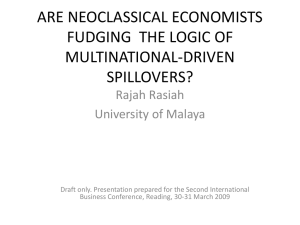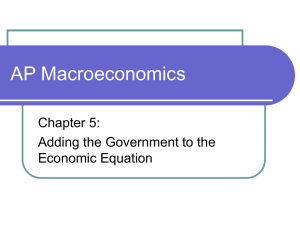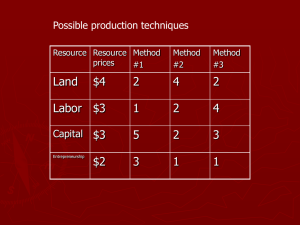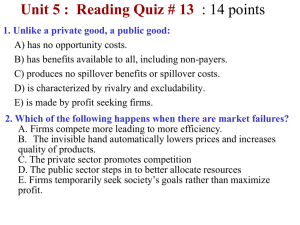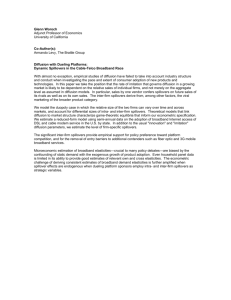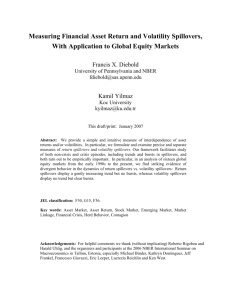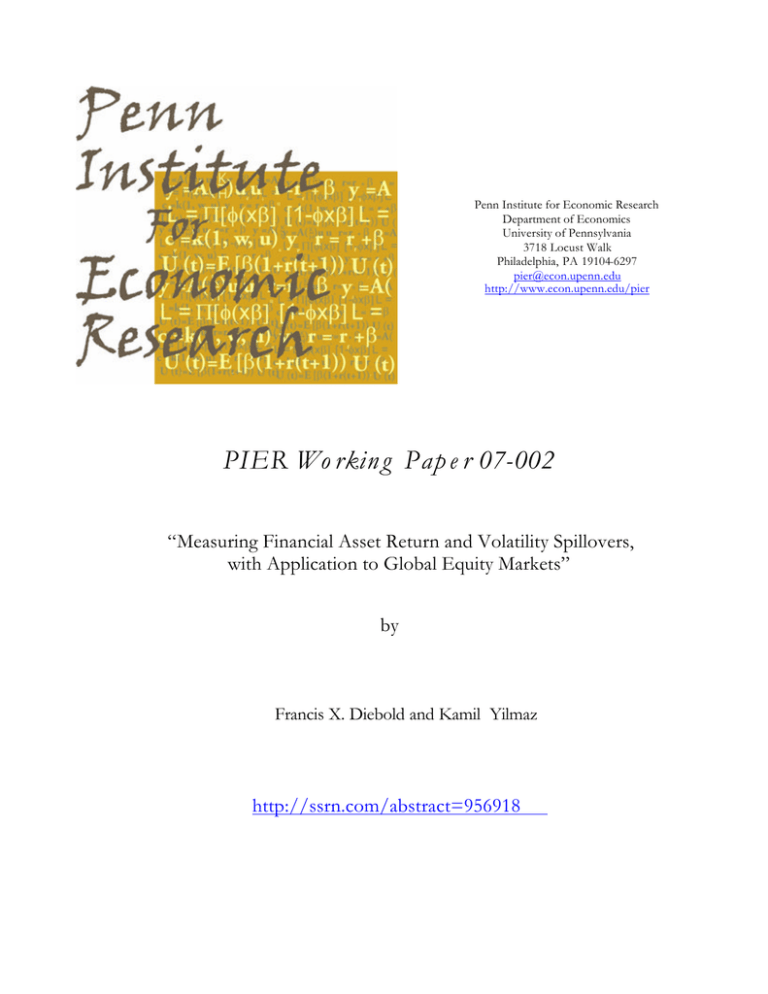
Penn Institute for Economic Research
Department of Economics
University of Pennsylvania
3718 Locust Walk
Philadelphia, PA 19104-6297
pier@econ.upenn.edu
http://www.econ.upenn.edu/pier
PIER Working Paper 07-002
“Measuring Financial Asset Return and Volatility Spillovers,
with Application to Global Equity Markets”
by
Francis X. Diebold and Kamil Yilmaz
http://ssrn.com/abstract=956918
Measuring Financial Asset Return and Volatility Spillovers,
With Application to Global Equity Markets
Francis X. Diebold
University of Pennsylvania and NBER
fdiebold@sas.upenn.edu
Kamil Yilmaz
Koc University
kyilmaz@ku.edu.tr
This draft/print: January 2007
Abstract: We provide a simple and intuitive measure of interdependence of asset
returns and/or volatilities. In particular, we formulate and examine precise and separate
measures of return spillovers and volatility spillovers. Our framework facilitates study
of both non-crisis and crisis episodes, including trends and bursts in spillovers, and
both turn out to be empirically important. In particular, in an analysis of sixteen global
equity markets from the early 1990s to the present, we find striking evidence of
divergent behavior in the dynamics of return spillovers vs. volatility spillovers: Return
spillovers display a gently increasing trend but no bursts, whereas volatility spillovers
display no trend but clear bursts.
JEL classification: F30, G15, F36.
Key words: Asset Market, Asset Return, Stock Market, Emerging Market, Market
Linkage, Financial Crisis, Herd Behavior, Contagion
Acknowledgements: For helpful comments we thank (without implicating) Roberto Rigobon and
Harald Uhlig, and the organizers and participants at the 2006 NBER International Seminar on
Macroeconomics in Tallinn, Estonia, especially Michael Binder, Kathryn Dominguez, Jeff
Frankel, Francesco Giavazzi, Eric Leeper, Lucrezia Reichlin and Ken West.
-1-
1. Introduction
For many years but especially following the late 1990s Asian crisis, much has been made
of the nature of financial market interdependence, both in terms of returns and return volatilities
(e.g., King, Sentana and Wadhwani, 1994; Forbes and Rigobon, 2002). Against this background,
we propose a simple quantitative measure of such interdependence, which we call a spillover
index, and associated tools that we call spillover tables and spillover plots.
The intensity of spillovers may of course vary over time, and the nature of any timevariation is of potentially great interest. We allow for it in an analysis of a broad set of global
equity returns and volatilities from the early 1990s to the present, and we show that spillovers are
important, spillover intensity is indeed time-varying, and the nature of the time-variation is
strikingly different for returns vs. volatilities.
We proceed by proposing the spillover index in Section 2 and describing our global equity
data in Section 3. We perform a full-sample spillover analysis in Section 4 and a rolling-sample
analysis allowing for time-varying spillovers in Section 5. We summarize and conclude in
Section 6.
2. The Spillover Index
We base our measurement of return and volatility spillovers on vector autoregressive
(VAR) models in the broad tradition of Engle, Ito and Lin (1990). Our approach, however, is
very different. We focus on variance decompositions, which allow us to aggregate spillover
effects across markets, distilling a wealth of information into a single spillover measure.
The basic spillover index idea is simple and intuitive, yet rigorous and replicable,
following directly from the familiar notion of a variance decomposition associated with an Nvariable vector autoregression. Roughly, for each asset i we simply add the shares of its forecast
error variance coming from shocks to asset j, for all j ≠ i , and then we add across all i = 1,..., N .
To minimize notational clutter, consider first the simple example of a covariance
stationary first-order two-variable VAR,
xt = Φxt −1 + ε t ,
-2-
where xt = ( x1,t , x2,t ) ' and Φ is a 2x2 parameter matrix. In our subsequent empirical work, x will
be either a vector of stock returns or a vector of stock return volatilities. By covariance
stationarity, the moving average representation of the VAR exists and is given by
xt = Θ( L)ε t ,
where Θ( L) = ( I − ΦL) −1 . It will prove useful to rewrite the moving average representation as
xt = A( L)ut ,
where A( L) = Θ( L)Qt−1 , ut = Qt ε t , E (ut ut, ) = I , and Qt−1 is the unique lower-triangular Cholesky
factor of the covariance matrix of ε t .
Now consider 1-step-ahead forecasting. Immediately, the optimal forecast (more
precisely, the Wiener-Kolmogorov linear least-squares forecast) is
xt +1,t = Φxt ,
with corresponding 1-step-ahead error vector
⎡a
et +1,t = xt +1 − xt +1,t = A0ut +1 = ⎢ 0,11
⎣ a0,21
a0,12 ⎤ ⎡ u1,t +1 ⎤
⎥⎢
⎥,
a0,22 ⎦ ⎣u2,t +1 ⎦
which has covariance matrix
E (et +1,t et' +1,t ) = A0 A0' .
2
2
+ a0,12
, and the
Hence, in particular, the variance of the 1-step-ahead error in forecasting x1t is a0,11
2
2
variance of the 1-step-ahead error in forecasting x2t is a0,21
+ a0,22
.
Variance decompositions allow us to split the forecast error variances of each variable
into parts attributable to the various system shocks. More precisely, for the example at hand, they
answer the questions: What fraction of the 1-step-ahead error variance in forecasting x1 is due to
shocks to x1 ? Shocks to x2 ? And similarly, what fraction of the 1-step-ahead error variance in
forecasting x2 is due to shocks to x1 ? Shocks to x2 ?
-3-
Let us define own variance shares to be the fractions of the 1-step-ahead error variances
in forecasting xi due to shocks to xi , for i=1, 2, and cross variance shares, or spillovers, to be the
fractions of the 1-step-ahead error variances in forecasting xi due to shocks to x j , for i, j=1, 2,
i ≠ j . There are two possible spillovers in our simple two-variable example: x1t shocks that
2
), and x2t shocks that affect the
affect the forecast error variance of x2t (with contribution a0,21
2
2
2
). Hence the total spillover is a0,12
+ a0,21
.
forecast error variance of x1t (with contribution a0,12
We can convert total spillover to an easily-interpreted index by expressing it relative to total
2
2
2
2
+ a0,12
+ a0,21
+ a0,22
= trace( A0 A0' ) . Expressing the ratio as a
forecast error variation, which is a0,11
percent, the Spillover Index is
S=
2
2
a0,12
+ a0,21
trace( A0 A0' )
i 100 .
Having illustrated the Spillover Index in a simple first-order two-variable case, it is a
simple matter to generalize it to richer dynamic environments. In particular, for a pth-order Nvariable VAR (but still using 1-step-ahead forecasts) we immediately have
N
∑a
S=
i , j =1
i≠ j
2
0,ij
trace( A0 A0' )
i 100 ,
and for the fully general case of a pth-order N-variable VAR, using H-step-ahead forecasts, we
have
H −1
N
∑ ∑a
S=
h=0
i , j =1
i≠ j
2
h ,ij
i 100 .
H −1
∑
h=0
'
h
trace( Ah A )
Such generality is often useful. In the empirical work that follows, for example, we use secondorder 16-variable VARs with 10-step-ahead forecasts.
-4-
3. Global Equity Market Return and Volatility Data
Our underlying data are daily nominal local-currency stock market indices, January 1992 September 2005, taken from Datastream and Global Financial Data. We use four major indices:
The Dow Jones Industrial Average for the New York Stock Exchange, the FTSE-100 index for
the London Stock Exchange, the Hang Seng index for the Hong Kong Stock Exchange, and the
Nikkei 225 index for the Tokyo Stock Exchange. Similarly, we use daily nominal local-currency
stock market indices for twelve emerging markets: Indonesia, South Korea, Malaysia,
Philippines, Singapore, Taiwan, Thailand, Argentina, Brazil, Chile, Mexico and Turkey.
We calculate returns as the change in log price, Wednesday-to-Wednesday. When price
data for Wednesday are not available due to a holiday, we use Thursday. We then convert
weekly returns from nominal to real terms using monthly consumer price indices from the IMF’s
International Financial Statistics. To do so we assume that the weekly inflation rate π t is
constant within the month, in which case we can calculate it simply as the 1/4th power of the
monthly inflation rate, and we then calculate the weekly real return as
1 + it
− 1 , where it is the
1+ πt
weekly nominal return. We provide a variety of descriptive statistics for returns in Table 1.
We assume that volatility is fixed within periods (in this case, weeks) but variable across
periods. Then, following Garman and Klass (1980) and Alizadeh, Brandt and Diebold (2002), we
can use weekly high, low, opening and closing prices obtained from underlying daily
high/low/open/close data to estimate weekly stock return volatility:
σ 2 = 0.511 ( H t − Lt ) 2 − 0.019 [ ( C t − O t )( H t + Lt − 2 O t ) − 2( H t − O t )( Lt − O t ) ] − 0.383( C t − O t ) 2 ,
where H is the Monday-Friday high, L is the Monday-Friday low, O is the Monday open and C is the
Friday close (all in natural logarithms). We provide descriptive statistics for volatilities in Table 2.
4. Full-Sample Analysis: Spillover Tables
Here we provide a full-sample analysis of global stock market return and volatility
spillovers. As part of that analysis, we propose decomposing the Spillover Index into all of the
forecast error variance components for variable i coming from shocks to variable j, for all i and j.
-5-
We begin by characterizing return and volatility spillovers over the entire sample, January
1992-September 2005. Subsequently we will track time variation in spillovers via rolling
window estimation.) We report Spillover Indexes for returns and volatility in the lower right
corners of Tables 3 and 4, respectively. Before discussing them, however, let us describe the rest
of the two tables, which we call Spillover Tables. The ij th entry in the table is the estimated
contribution to the forecast error variance of country i (returns in Table 3, volatility in Table 4)
coming from innovations to country j (again, returns in Table 3, volatility in Table 4).1 Hence the
off-diagonal column sums (labeled Contributions to Others) or row sums (labeled Contributions
from Others), when totaled across countries, give the numerator of the Spillover Index. Similarly,
the column sums or row sums (including diagonals), when totaled across countries, give the
denominator of the Spillover Index.
The Spillover Table, then, provides an “input-output” decomposition of the Spillover
Index. For example, we learn from Spillover Table 3 (for returns) that innovations to U.S. returns
are responsible for 18.1 percent of the error variance in forecasting 10-week-ahead Mexican
returns, but only 3.1 percent of the error variance in forecasting 10-week-ahead Turkish returns.
That is, return spillovers from the U.S. to Mexico are larger than for the U.S. to Turkey. As
another example, we see from Table 4 (volatility) that total volatility spillovers from Hong Kong
to others (that is, Hong Kong Contributions to Others) are much large than total volatility
spillovers from others to Hong Kong (Hong Kong Contributions from Others).
The key substantive summary result to emerge from Tables 3 and 4 is that, distilling all of
the various cross-country spillovers into a single Spillover Index for our full 1992-2005 data
sample, we find that approximately thirty percent of forecast error variance comes from spillovers,
both for returns (29 percent) and volatilities (31 percent). Hence spillovers are important in both
returns and volatilities, and on average – that is, unconditionally – return and volatility spillovers
are of the same magnitude.
However, at any given point in time – that is, conditionally – return and volatility
spillovers may be very different, and more generally, their dynamics may be very different. We
1
The results are based on weekly vector autoregressions of order 2 (selected using the Schwarz criterion), identified
using a Cholesky factorization with the ordering as shown in the column heading, and 10-week-ahead forecasts.
-6-
now substantiate these assertions by moving from a static full-sample analysis to a dynamic
rolling-sample analysis.
5. Rolling-Sample Analysis: Spillover Plots
Clearly, many changes took place during the years in our sample, 1992-2005. Some are
well-described as more-or-less continuous evolution, such as increased linkages among global
financial markets and increased mobility of capital, due to globalization, the move to electronic
trading, and the rise of hedge funds. Others are better described as bursts that subsequently
subside, such as the various Asian currency crises around 1997.
Given this background of financial market evolution and turbulence, it seems unlikely that
any single fixed-parameter model would apply over the entire sample. Hence the full-sample
Spillover Tables and Spillover Indexes obtained earlier, although providing a useful summary of
“average” behavior, likely miss the potentially important secular and cyclical movements in
spillovers. To address this issue, we now estimate the models using 200-week rolling samples,
and we assess the extent and nature of spillover variation over time via the corresponding time
series of Spillover Indexes, which we examine graphically in Spillover Plots.
In Figure 1, we present the Spillover Plot for returns. It is largely uneventful, displaying a
gently increasing trend, but little else. Notice that even as the estimation window moves beyond
the mid-1990s, the Spillover Plot never declines to its early lower range. This is consistent with a
maintained increase in financial market integration.
The Spillover Plot for volatilities, which we present in Figure 2, is radically different. It
ranges widely and responds to economic events. Some of those events are major, such as the East
Asian currency crises in late 1997 (the devaluation of Thai Baht in July 1997, the spread to Hong
Kong in October 1997, and further spread to other major economies in the region such as South
Korea, Malaysia and Indonesia through January 1998). Another example is the June-August
1998 Russian crisis (the first wave was controlled by the IMF’s announcement of a support
package in June 1998, and the final outbreak occurred in August 1998). Both of these crises
produced a large spike in volatility spillovers.
-7-
Interestingly, volatility spillovers also respond to less major (but nevertheless important
and well-known) crises. For example, comparatively minor emerging market crises are reflected
in small spikes in the volatility spillover measures. Indeed, during our sample period there were
nine widely-acknowledged crisis events: (1) The Mexican crisis of December 1994 - January
1995, (2) the East Asian crisis of October - December 1997, (3) the Russian crisis of August September 1998, (4) the Brazilian crisis of January 1999, (5) the Turkish Crisis of December
2000 - February 2001, (6) the U.S. terrorist attack of September 11, 2001, (7) the Argentinean
Crisis of November 2001, (8) the downgrading to junk status of GM and Ford debt, followed by a
short-lived reversal of international capital flows from emerging market economies, of March
2005, (9) the intense reversal of capital flows from emerging markets of May-June 2006. All of
these events generated increases in volatility spillovers, as shown in Figure 2, whereas none
generated movements in return spillovers.
6. Summary and Concluding Remarks
We have proposed a simple framework for measuring linkages in asset returns and return
volatilities. In particular, we have formulated and examined precise measures of return
spillovers and volatility spillovers based directly on the familiar notion of vector autoregressive
variance decompositions. Our spillover measures have the appealing virtue of conveying
important and useful information while nevertheless sidestepping the contentious issue of
definition and existence of episodes of “contagion” so vigorously debated in recent literature
such as Forbes and Rigobon (2002).
Our framework facilitates study of both crisis and non-crisis episodes, including trends as
well as bursts in spillovers. In an analysis of sixteen global equity markets from the early 1990s
to the present, we find striking evidence of divergent behavior in the dynamics of return
spillovers vs. volatility spillovers. Return spillovers display no bursts but a gently increasing
trend, presumably associated with the gradually increasing financial market integration of the last
fifteen years. Volatility spillovers, in contrast, display no trend but clear bursts associated with
readily-identified “crisis” events.
Although we have not reported them here in order to conserve space, we have performed
several variations on the basic theme reported here, and our results appear robust. Such
-8-
variations include but are not limited to the VAR lag order, the width of the rolling VAR
estimation window, and the forecast horizon for variance decompositions.
-9-
References
Alizadeh, Sassan, Michael W. Brandt and Francis X. Diebold (2002), “Range-Based Estimation
of Stochastic Volatility Models,” Journal of Finance, 57, 1047-1092.
Engle, Robert F., Takatoshi Ito and Wen-Ling Lin (1990), “Meteor Showers or Heat Waves?
Heteroskedastic Intra-Daily Volatility in the Foreign Exchange Market,” Econometrica, 58, 525542.
Forbes, Kristen J. and Roberto Rigobon (2002), “No Contagion, Only Interdependence:
Measuring Stock Market Comovements,” Journal of Finance, 57, 2223-2261.
Garman, Mark B. and Michael J. Klass (1980), “On the Estimation of Security Price Volatilities
from Historical Data,” Journal of Business, 53, 67-78.
King, Mervyn, Enrique Sentana and Sushil Wadhwani (1994), “Volatility and Links Between
National Stock Markets,” Econometrica, 62, 901-933.
-10-
Table 1
Descriptive Statistics, Global Stock Market RETURNS, 1/1992 – 9/2005
Mean
Median
Maximum
Minimum
Std. Dev.
Skewness
Kurtosis
Mean
Median
Maximum
Minimum
Std. Dev.
Skewness
Kurtosis
United
United
Hong
South
States
Kingdom Kong
Japan
Indonesia Korea Malaysia Philippines
US
UK
HKG
KOR
JPN
IDN
MYS
PHL
0.00112 0.00057 0.00130 -0.00079 -0.00033 0.00011 0.00014
-0.00056
0.00186 0.00156 0.00219
0.00041
0.00142 -0.0007 0.00040
-0.00091
0.0976
0.1349
0.1370
0.1205
0.1684 0.1657
0.2791
0.1349
-0.0932
-0.1035 -0.1423
-0.1024
-0.1304 -0.1797 -0.2101
-0.1550
0.0211
0.0228
0.0349
0.0302
0.0353 0.0427
0.0361
0.0364
-0.1607
0.2515 -0.4493
0.0388
-0.0965 -0.0495
0.4289
0.1019
5.18
6.90
4.48
4.21
5.62
4.76
11.80
4.51
Singapore Taiwan Thailand Argentina Brazil
Chile
Mexico
Turkey
SGP
TAI
THA
ARG
BRA
CHL
MEX
TUR
0.00067 0.00006 -0.00070
0.00008
0.00187 0.00080 0.00087
0.00050
-0.00018 0.00167 0.00036
0.00429
0.00734 0.00102 0.00154
0.00191
0.1467
0.1485
0.1930
0.2571
0.3054 0.0946
0.1739
0.2589
-0.1165
-0.1160 -0.1397
-0.2216
-0.2786 -0.1136 -0.1319
-0.3313
0.0300
0.0371
0.0412
0.0546
0.0593 0.0210
0.0382
0.0680
0.0674
0.0498
0.2416
-0.3485
-0.5742 -0.0109 -0.0140
-0.2868
5.43
3.98
4.41
4.84
7.40
6.02
4.55
5.55
Notes: Returns are in real terms and measured weekly, Wednesday-to-Wednesday. The sample size is 717. See text
for details.
Table 2
Descriptive Statistics, Global Stock Market VOLATILITY, 1/1992 – 9/2005
US
Mean
Median
Maximum
Minimum
Std. Dev.
Skewness
Kurtosis
HKG
JPN
0.00043 0.00051 0.00106 0.00076
0.00025 0.00025 0.00057 0.00053
0.00595 0.00926 0.03794 0.00798
1.98E-05 1.14E-05 1.55E-05 1.88E-05
0.00058 0.00083 0.00216 0.00082
4.330
5.248
9.839
3.473
29.221
41.012 141.313
21.203
SGP
Mean
Median
Maximum
Minimum
Std. Dev.
Skewness
Kurtosis
UK
TAI
THA
ARG
0.00045 0.00085 0.00118 0.00204
0.00018 0.00053 0.00063 0.00096
0.0105 0.01376 0.01699 0.03371
6.21E-07 9.38E-06 5.22E-05 6.41E-06
0.00082 0.00104
0.0017 0.00344
5.201
4.648
4.393
4.761
44.325
43.029
30.862
32.769
IDN
KOR
MYS
PHL
0.00091 0.00138 0.00093 0.00066
0.00036 0.00069 0.00027 0.00033
0.02074 0.01869 0.04592 0.01798
3.97E-07 8.22E-10 4.41E-06 4.74E-06
0.00178 0.00204 0.00306 0.00145
4.918 3.63574
9.9146 8.06104
36.495
20.574 121.400
85.161
BRA
CHL
MEX
TUR
0.00225 0.00018 0.00104 0.00344
0.00115 8.21E-05 0.00053 0.00165
0.06133 0.00816 0.02871 0.07689
1.22E-08 1.77E-07 7.18E-07 6.67E-07
0.00445 0.00043 0.00189 0.00572
7.331
11.232
7.694
6.442
74.263 178.011
89.782
66.010
Notes: Volatilities are for Monday-to-Friday returns. The mnemonics are as in Table 1. We calculate Chile’s
volatility using the Santiago Stock Exchange IGPA Index for 1/1992 – 5/2004 and the Santiago Stock Exchange
IPSA index for 6/2004 – 9/2005. The sample size is 717. See text for details.
-11-
Table 3
Spillover Table, Global Stock Market RETURNS, 1/1992-9/2005
FROM
TUR
Contribution
From Others
0.0
0.1
5
0.0
0.1
0.4
42
0.5
0.4
0.0
0.1
29
0.0
0.0
1.2
0.3
0.1
21
0.7
0.9
0.5
0.3
0.6
0.2
21
0.1
0.4
0.4
0.2
0.1
0.1
0.1
24
0.1
0.1
0.1
0.2
0.5
0.1
0.1
0.0
27
66.0
0.3
0.8
1.8
1.5
0.0
0.1
0.2
0.1
34
6.9
1.7
41.4
0.5
0.7
0.6
0.6
0.2
0.0
0.0
59
1.5
1.9
0.2
0.7
77.7
0.2
0.1
0.0
0.2
0.3
0.2
22
9.7
3.7
3.6
1.2
0.9
0.3
59.2
1.1
0.2
0.4
0.3
0.1
41
0.9
0.7
0.2
0.2
0.6
0.7
1.2
0.5
82.6
0.1
0.3
0.6
0.2
17
1.9
1.3
0.1
0.8
1.0
0.6
0.2
0.2
0.2
7.6
71.6
0.2
0.4
0.2
28
1.0
4.9
0.9
1.8
0.1
0.5
0.2
0.9
0.6
1.6
4.0
5.7
68.3
1.0
0.2
32
18.1
3.9
3.8
0.8
0.2
0.6
0.1
0.2
0.2
0.3
0.5
9.2
4.0
1.2
56.8
0.1
43
3.1
TUR
Contribution
174
To Others
Contribution
269
Including Own
1.9
0.5
1.0
0.8
0.4
0.3
0.1
0.6
0.3
0.7
0.4
0.7
0.4
0.5
88.1
12
42
78
16
35
14
19
8
6
6
9
26
13
5
5
2
458
100
149
96
114
89
92
74
47
84
68
109
85
74
61
90
Spillover
Index = 29%
TO
US
UK
HKG JPN
IDN KOR MYS PHL SGP TAI THA ARG
BRA CHL MEX
US
95.4
0.4
1.0
0.4
0.0
0.4
0.1
0.8
0.3
0.1
0.2
0.4
0.2
0.2
UK
39.1
57.8
0.2
0.5
0.3
0.1
0.2
0.7
0.0
0.1
0.4
0.0
0.1
HKG
16.0
9.0
70.9
0.3
0.2
0.4
1.0
0.1
0.1
0.6
0.4
0.1
JPN
11.4
3.4
2.2
79.4
0.1
0.4
0.4
0.2
0.0
0.5
0.5
IDN
6.4
1.9
5.7
1.0
79.0
1.3
0.3
0.6
0.4
0.2
KOR
6.8
3.7
6.6
4.2
1.4
75.5
0.1
0.5
0.0
MYS
4.1
1.5
11.0
0.5
7.6
1.0
72.8
0.1
PHL
8.8
1.7
7.1
0.2
7.5
1.5
2.3
SGP
15.8
5.6
18.8
1.5
4.0
1.6
TAI
7.7
1.5
4.9
2.5
0.3
THA
7.9
3.3
7.9
0.1
ARG
7.5
2.0
1.8
BRA
12.8
0.9
CHL
8.2
MEX
Notes: We present variance decompositions based upon a weekly vector autoregression of order 2 identified using a Cholesky factorization with the ordering as
shown in the column heading. The (i, j)-th value is the estimated contribution TO the variance of the 10-week-ahead real stock return forecast error of country i
coming FROM innovations to real stock returns of country j. The mnemonics are defined as in Table 1.
-12-
Table 4
Spillover Table, Global Stock Market VOLATILITY, 1/1992-9/2005
FROM
US
TO
UK HKG JPN IDN KOR MYS PHL SGP TAI THA ARG BRA CHL MEX TUR
Contribution
From Others
US
69.1 17.2 5.6
0.2
0.3
1.4
0.8
0.6
1.7
0.2
0.1
0.2
0.1
0.1
0.1
2.3
31
UK
28.9 57.1 7.8
0.5
0.4
1.0
0.5
0.1
1.2
0.2
0.2
0.5
0.3
0.2
0.4
0.7
43
HKG
1.7
0.5 89.0 0.1
0.5
1.2
0.5
1.6
3.0
0.6
0.7
0.0
0.1
0.0
0.1
0.3
11
JPN
3.4
3.2
1.8 84.8
0.0
0.7
1.0
0.2
1.0
0.2
0.0
0.5
0.3
0.1
0.0
2.7
15
IDN
2.3
0.7
6.6
0.5
73.4
7.1
2.2
2.8
2.2
0.7
0.1
0.0
0.1
0.3
0.1
0.9
27
KOR
4.1
0.7
9.0
1.1
10.6
68.5
1.2
1.1
1.6
0.7
0.3
0.1
0.2
0.0
0.1
0.7
31
MYS
1.1
0.6
7.6
1.2
0.9
1.5
72.1
3.3
4.8
0.4
0.5
1.1
0.7
0.2
1.8
2.3
28
PHL
1.3
0.3
9.2
0.4
8.9
3.3
6.4
67.1
1.2
0.1
0.3
0.3
0.3
0.2
0.3
0.5
33
SGP
10.1
3.9 13.5 1.0
8.0
7.6
2.6
1.6
47.1
0.7
0.2
1.1
0.6
0.0
0.5
1.5
53
TAI
9.3
0.3
0.6
0.6
8.8
0.8
2.0
0.5
71.4
0.5
0.3
0.9
0.1
0.5
0.9
29
THA
0.6
0.8 11.4 0.3
4.5
3.5
0.4
1.3
7.5
0.5
67.5
0.1
0.5
0.1
0.8
0.2
32
ARG
2.8
1.3
0.5
0.3
0.1
2.2
0.2
0.4
0.3
0.7
85.0
1.0
0.3
0.7
1.1
15
BRA
2.7
2.3 13.7 0.3
1.0
0.3
10.4
0.8
2.5
0.5
0.2
14.0
48.2
0.1
1.9
1.0
52
CHL
0.5
0.6
0.1
1.0
0.2
3.2
0.1
0.7
0.3
0.2
5.4
7.4
75.8
0.2
0.1
24
MEX
5.8
1.2 27.1 0.3
0.5
0.5
2.7
0.4
1.5
0.2
0.7
7.4
3.0
0.6
47.2
1.0
53
3.2
1.5
4.1
0.4
0.4
1.0
2.7
0.5
0.7
3.8
0.1
0.8
0.2
0.4
1.3
79.0
21
78
35
127
7
38
38
38
17
30
9
5
32
16
3
9
16
498
147
92
216
92
111
107
110
84
77
81
72
117
64
79
56
95
Spillover
Index = 31%
TUR
Contribution
To Others
Contribution
Including Own
2.6
3.0
4.3
Notes: We present variance decompositions based upon a weekly vector autoregression of order 2 identified using a Cholesky factorization with the ordering as
shown in the column heading. The (i, j)-th value is the estimated contribution TO the variance of the 10-week-ahead stock return volatility forecast error of
country i coming FROM innovations to the stock return volatility of country j. We calculate Chile’s volatility using the Santiago Stock Exchange IGPA Index
for January 1992-May 2004, and the Santiago Stock Exchange IPSA index for June 2004-September 2005. The mnemonics are defined as in Table 1.
-13-
Figure 1
Spillover Plot, Global Stock Market RETURNS, 11/1995-9/2005
90
80
Index
70
60
50
40
30
11/95
11/96
11/97
11/98
11/99
11/00
11/01
Ending Date of Window
11/02
11/03
11/04
Notes: The return Spillover Index is the sum of all variance decomposition “contributions to others” from Table 3,
estimated using a 200-week rolling window. See text for details.
Figure 2
Spillover Plot, Global Stock Market VOLATILITY, 11/1995-9/2005
90
Virus spread
to other EA
markets
Russian
crisis
80
Index
70
Russian crisis
data out
Turkish
crisis
Virus spread
to HongKong
GM/Ford
bonds giv en
junk-bond status
9/11
terrorist
attacks
60
50
9/11 data
out
Brazilian
crisis
Rev ersal in
Fed Interest
rate policy
stance
Crisis in
Thailand
40
30
11/95
11/96
11/97
11/98
11/99
11/00
11/01
Ending Date of Window
11/02
11/03
11/04
Notes: The volatility Spillover Index is the sum of all variance decomposition “contributions to others” from Table 4,
estimated using a 200-week rolling window. See text for details.
SSRN-Measuring Financial Asset Return and Volatility Spillovers, With Application to Global Equity Markets by Francis Diebold, Kamil Yilmaz
Hello PIER (Penn Institute for Econ). (If you are not PIER (Penn Institute for Econ) Submitter, click here.)
Measuring Financial Asset Return and Volatility
Spillovers, With Application to Global Equity Markets
Paper Stats:
Abstract Views: 1
Downloads: 0
FRANCIS X. DIEBOLD
University of Pennsylvania - Department of Economics; National Bureau of Economic
Research (NBER)
KAMIL YILMAZ
Koc University - Department of Economics
PIER Working Paper No. 07-002
Abstract:
We provide a simple and intuitive measure of interdependence of asset
returns and/or volatilities. In particular, we formulate and examine precise and
separate measures of return spillovers and volatility spillovers. Our framework
facilitates study of both non-crisis and crisis episodes, including trends and
bursts in spillovers, and both turn out to be empirically important. In particular,
in an analysis of sixteen global equity markets from the early 1990s to the
present, we find striking evidence of divergent behavior in the dynamics of
return spillovers vs. volatility spillovers: Return spillovers display a gently
increasing trend but no bursts, whereas volatility spillovers display no trend
but clear bursts.
Keywords: : Asset Market, Asset Return, Stock Market, Emerging Market, Market Linkage,
Financial Crisis, Herd Behavior, Contagion
JEL Classifications: F30, G15, F36
Accepted Paper Series
http://papers.ssrn.com/sol3/papers.cfm?abstract_id=956918 (1 of 2) [1/12/2007 11:59:52 AM]
SSRN-Measuring Financial Asset Return and Volatility Spillovers, With Application to Global Equity Markets by Francis Diebold, Kamil Yilmaz
Contact Information for FRANCIS X. DIEBOLD (Contact Author)
Email address for FRANCIS X. DIEBOLD
University of Pennsylvania - Department of Economics
3718 Locust Walk
Philadelphia , PA 19104
United States
215-898-1507 (Phone)
215-573-4217 (Fax)
(No e-mail address available for FRANCIS X. DIEBOLD
National Bureau of Economic Research (NBER)
1050 Massachusetts Avenue
Cambridge , MA 02138
United States
Contact Information for KAMIL YILMAZ
Email address for KAMIL YILMAZ
Koc University - Department of Economics
Rumeli Feneri Yolu
Sariyer 80910, Istanbul
Turkey
+90 212 338 1458 (Phone)
+90 212 338 1653 (Fax)
Email Abstract or URL
SSRN Resources
To search for other abstracts in the SSRN archival database, click here.
To order a membership to an SSRN Network or to subscribe to one or more
of SSRN's journals, go to our online subscription request form.
To go to SSRN's main web site (www.ssrn.com), click here.
© 2007 Social Science Electronic Publishing, Inc. All Rights Reserved. Terms of Use
This page was served by hermes3 in 0.47 seconds.
http://papers.ssrn.com/sol3/papers.cfm?abstract_id=956918 (2 of 2) [1/12/2007 11:59:52 AM]

![[DOCX 51.43KB]](http://s3.studylib.net/store/data/007172908_1-9fbe7e9e1240b01879b0c095d6b49d99-300x300.png)
